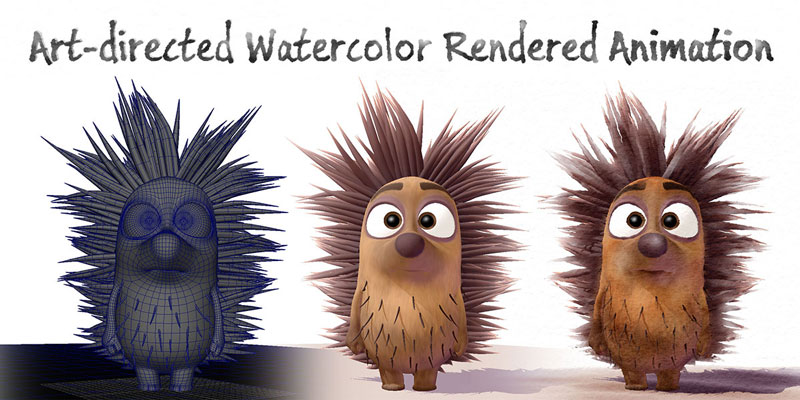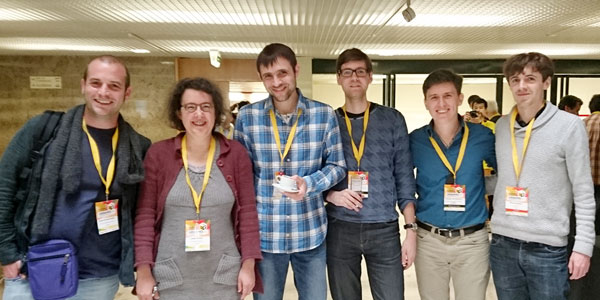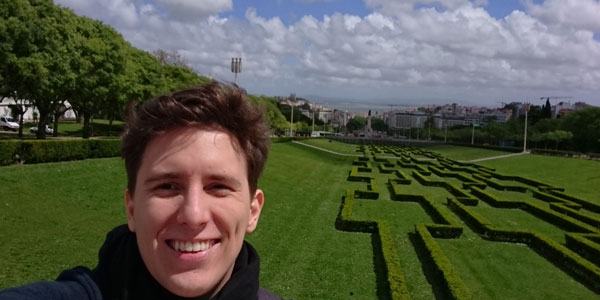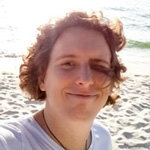Writing my first paper
— January-February
What an incredibly busy start of the year this has been… A productive one, however, quite intense. Once I came back to Singapore from a peaceful recovery during the Christmas holidays with my family - we went to San Francisco and Lake Tahoe! -, I noticed that the deadline for the technical paper I had planned was shifted. It was not due end of march, as it had been in previous years, instead it was moved to the beginning of February! This in turn put my scheduling upside down and created an avalanche of unexpected work.
I was planning to write my first paper for Expressive, a symposium specialized, as the name implies, in expressive computer graphics. My research in watercolor rendering would fit the bill perfectly, however, the system was far from ready as it still missed a crucial feature - art-direction. As soon as I came back, I went to work 24/7 in order to develop the missing algorithms/ui. Additionally, I had to write an 8-page technical paper and create an accompanying video, which would show the benefits of the art-directed watercolor rendering system. Thankfully, the deadline got extended for 10 additional days. And, one day before the extended deadline… I submitted! My paper, product of sweat, blood and a lot of arguments and fights with my second girlfriend, Autodesk Maya, was finalized: Art-directed Watercolor Rendered Animation.
Catching up with 2016
— March-April
Now, the semester was already over a month in - and I was supposed to attend my final courses. There was a lot to catch up, especially regarding assignments as I was taking two courses, 2D & 3D Animation and Virtual Reality. Here at the Nanyang Technological University (NTU) in Singapore, taking a normal course usually involves a heavy workload of assignments, which count towards your final grade – combined with exams. For one of my courses, 2D & 3D Animation, I had a project assignment which involved a shortfilm! There were also other alternatives, such as creating an IK system from scratch, but I decided to put the watercolor system to test, on a real production example.
I knew I wouldn’t have much time because of the potential revisions my paper would have, if accepted. Additionally, we were practicing regularly for the biggest Lindy Hop performance of the year (yes I dance Lindy Hop now ;). With my time constraints in mind, I still went ahead and modeled, rigged and skinned a character called Geist! I resorted to use the Advanced Skeleton Rig in order to accelerate the rigging process. However, I decided to create a facial bone rigging system, as existing solutions did not allow the control I wanted to have in him. The character was originally intended to have a mouth but was left without one, for now. The proper skinning for the character took probably the longest as I did not want to spend much time later on tweaking and creating corrective shapes. And it paid off, the final character didn’t require a single corrective shape! Once I was finished with Geist, I was ready to create the environment and start animating. Nonetheless, the big news came in that my paper had been accepted into Expressive 2016 in Lisbon, Portugal!
The comments of the anonymous reviewers were quite positive and there were only a few amendments to be done. All reviewers looked forward to see the system in action once the presentation would take place, at the actual conference in May. The revision and the final version of the paper and video didn’t take longer than a couple of days. This was great, as I couldn’t work during the week in the evenings anymore (2 nights with classes, 3 nights with Lindy Hop). We had some time consuming Lindy Hop rehearsals until we finally had our performance at the Nanyang Auditorium.
After the performance, having three more nights a week to work on, was a huge deal in crunch time. This, together with the weekends, allowed me to finish the shortfilm on time! It was an extremely simple story and the animation was rushed, however, I managed to learn a lot from it. This production opportunity enabled me to learn what still needs to be improved in the watercolor system that I am currently developing. Many ideas for future alternatives/solutions came to mind, which would be more artist friendly and would provide a more truthful look to traditional watercolors. I can’t wait to work on these improvements! But for now, you can watch the actual shortfilm here:
Every flower counts!
After the short film was finally done, I dedicated one week to the accumulated assignments of the Virtual Reality course and created the website at which you are currently reading this blog post from.
The presentation for the accepted Expressive paper also needed to be done while I had to take two exams full of math and physics concepts. I wrote my last exam on the 4th of May and I was sitting in an airplane on the very next day. I wish I could say that I was just relaxing on my way to the Expressive - which was going to take place in Lisbon, Portugal. But I was actually addressing and fine-tuning some final points in my presentation.
Expressive 2016
— 7th-9th May
Expressive was co-located with the Eurographics conference and runs shortly before it. Expressive is a symposium which contains different workshops and it is so specialized that you get to meet most of the non-photorealistic rendering (NPR) researchers personally! In big conferences, it is hard to catch key researchers, as they will be surrounded by others and extremely busy at such a big event. At Expressive, you have enough time to meet them all and even hang out to eat together and have some drinks! It was awesome to meet researchers like Pierre Bénard, Joëlle Thollot, Ammir Semmo, David Vanderhaeghe, Tobias Isenberg, Ergun Akleman and Jürgen Dollner. For you, it will probably be a list of random names. However, if you were to be doing research in non-photorealistic rendering, these people are epic! I have been doing research in NTU mostly on my own for the past two years. Therefore, to meet them was kind of a big deal! They were people whom I could completely geek out with, about watercolors and how awesome it would be to have proper non-photorealistic rendering as an animation and storytelling toolset!
At such a symposium, you also get to know other interesting researchers which don’t necessarily specialize in your field, but in highly related ones such as image stylization, expressive interaction and image synthesis. Some memorable names, which I had the pleasure of meeting were Esteban Garcia, Benoit Arbelot, David Mould, Yotam Gingold, Lars Doyle, Catarina Maçãs, Penousal Machado and Kapil Dev. There were of course more researchers which I unfortunately didn’t have the pleasure to meet. All in all, I believe we were over 40 people in the symposium from all around the world.
The presentation of my paper was on the second day of Expressive. I have to admit that I was quite nervous to talk to so many professionals in my research area. Normally I don’t think too much about presentations and just stand out there and go through it. But it is different in a room filled with interested people that truly understand what you want to achieve and the challenges it presents. In a way, it was also a confirmation to myself, to find out if the last two years of my studies had paid off and how it would be received by other researchers. After talking for over 20 minutes and giving a live demo of the working art-directable watercolor system, the reception was indeed great! I received some wonderful questions and praise by the audience, it was really humbling to see my work being appreciated.

That was it! The whole avalanche of work which 2016 created, had ceased. Courses and exams: check; shortfilm: check; Lindy Hop: check; paper and presentation: double check! A huge pile of relief sank in. From this point onwards, I could really enjoy the rest of the presentations and the keynotes with peace of mind. It was truly a wonderful experience! I received great feedback and had some candid discussions about non-photorealistic rendering, the future of NPR and the potential future steps regarding my research. We also talked about a collaboration towards bringing the research we do to artists’ hands and sharing assets, which would make our research easier, such as a database of animated geometry. I also look forward to work together to widen the use of non-photorealistic rendering. As researchers, we also need to create NPR tools which any artist outside of big animation studios can use, regardless if they have dedicated research facilities or not. I believe that NPR research should go out and be in the hands of independent artists, who could go creatively wild and do potentially amazing things, unbound by any financial and bureaucratic constraints… This will not only benefit them but also the future NPR researchers as adoption drives the change.
The last two days in Lisbon were dedicated to explore this beautiful but unfortunately rainy city. It reminds me a little bit of the Czech Republic but with a more southern flair. It was awesome to have some affordable European food once again! I missed it… The “western” food you get in Singapore is simply not comparable. Though I have to admit, I do look forward to have some delicious curry back home in Singapore!


Onwards
— 12th May onwards
I’m writing most of this blog post on my flight back to Singapore now. I look forward to the coming months, on how my research experience will change without coursework or imminent dance performances. There is an incoming animation project with Davide Benvenuti at which I will provide the non-photorealistic look. I also want to collaborate with researchers worldwide to widen the adoption of NPR techniques!
On a final note, Artella, the collaborative production platform that I talked about previously, was finally released to the public. They already have some cool projects going on. Feel free to join and maybe freelance a bit in whichever role you want to! I have been thinking of using Artella also as a way to bridge research and artists worldwide. I’m sure there would be quite a number of artists who would love to try out and play with novel NPR techniques. Exciting times, who knows what’s going to happen next, I’ll keep you updated!
P.S. Expressive paper, video and presentation can be seen here

